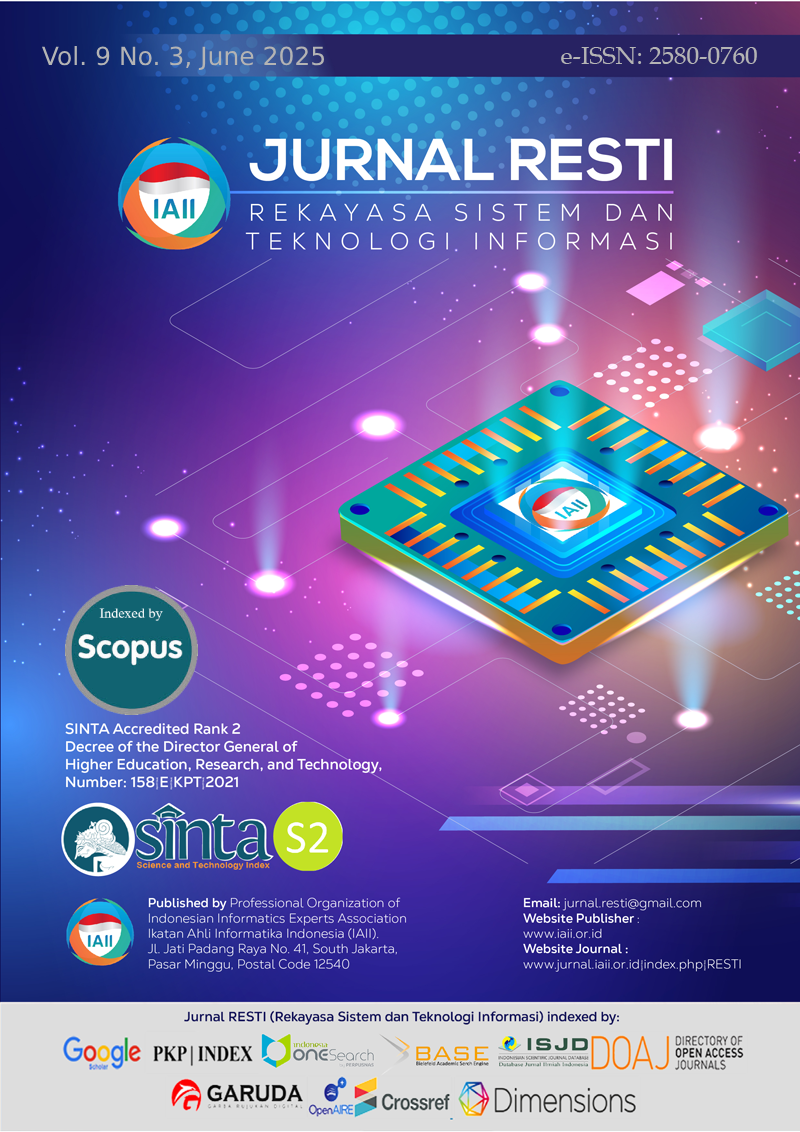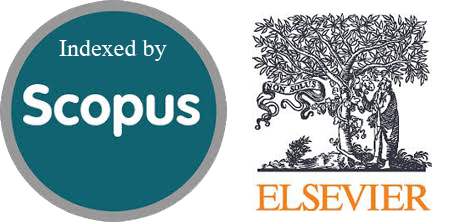Enhancing Tomato Leaf Disease Detection via Optimized VGG16 and Transfer Learning Techniques
Abstract
Identification of tomato leaf disease remains difficult because standard approaches are frequently incorrect in identifying distinct signs. Convolutional Neural Networks (CNNs) perform well in image classification and pattern identification, although they are prone to overfitting. Thus, max pooling was employed to reduce dimensionality while retaining crucial information. This paper offers an improved CNN through hyperparameter tuning and compares it to Transfer Learning models such as InceptionV3, NASNetMobile, and VGG16, which were chosen for their efficiency and accuracy. The dataset comprises 7,178 photos classified as Healthy, Leaf Late Blight, Septoria Leaf Spot, and Yellow Leaf Curl Virus, collected from Kaggle.. The dataset is separated into three sections: training, validation, and testing, with a ratio of 70:15:15. The results of this study revealed that the proposed method achieved the highest accuracy of 98.24%. In the application of transfer learning, the inceptionV3 model achieved an accuracy of 96.94%, whereas NASNetMobile obtained 97.50%, and VGG16 showed an accuracy of 96.76%. The evaluation is based on accuracy, precision, recall, F1-score and Inference time to determine the optimum model for accuracy and computing efficiency. This project uses the proposed method and Transfer Learning Techniques to categorize illness images on tomato leaves. These findings will drive further research to improve tehe performance of the proposed method for foliar disease classification and comparable applications.
Downloads
References
L. Tan, J. Lu, and H. Jiang, “Tomato Leaf Diseases Classification Based on Leaf Images: A Comparison between Classical Machine Learning and Deep Learning Methods,” AgriEngineering, vol. 3, no. 3, pp. 542–558, 2021, doi: 10.3390/agriengineering3030035.
S. Zhao, Y. Peng, J. Liu, and S. Wu, “Tomato leaf disease diagnosis based on improved convolution neural network by attention module,” Agric., vol. 11, no. 7, 2021, doi: 10.3390/agriculture11070651.
T. Anandhakrishnan and S. M. Jaisakthi, “Deep Convolutional Neural Networks for image based tomato leaf disease detection,” Sustain. Chem. Pharm., vol. 30, 2022, doi: 10.1016/j.scp.2022.100793.
A. Bhujel, N. E. Kim, E. Arulmozhi, J. K. Basak, and H. T. Kim, “A Lightweight Attention-Based Convolutional Neural Networks for Tomato Leaf Disease Classification,” Agric., vol. 12, no. 2, 2022, doi: 10.3390/agriculture12020228.
R. Thangaraj, S. Anandamurugan, and V. K. Kaliappan, “Automated tomato leaf disease classification using transfer learning-based deep convolution neural network,” J. Plant Dis. Prot., vol. 128, no. 1, pp. 73–86, 2021, doi: 10.1007/s41348-020-00403-0.
O. Attallah, “Tomato Leaf Disease Classification via Compact Convolutional Neural Networks with Transfer Learning and Feature Selection,” Horticulturae, vol. 9, no. 2, 2023, doi: 10.3390/horticulturae9020149.
P. Kaur, S. Harnal, V. Gautam, M. P. Singh, and S. P. Singh, “An approach for characterization of infected area in tomato leaf disease based on deep learning and object detection technique,” Eng. Appl. Artif. Intell., vol. 115, 2022, doi: 10.1016/j.engappai.2022.105210.
S. G. Paul et al., “A real-time application-based convolutional neural network approach for tomato leaf disease classification,” Array, vol. 19, 2023, doi: 10.1016/j.array.2023.100313.
T. H. Nguyen, T. N. Nguyen, and B. V. Ngo, “A VGG-19 Model with Transfer Learning and Image Segmentation for Classification of Tomato Leaf Disease,” AgriEngineering, vol. 4, no. 4, pp. 871–887, 2022, doi: 10.3390/agriengineering4040056.
J. Yue et al., “Hyperspectral-to-image transform and CNN transfer learning enhancing soybean LCC estimation,” Comput. Electron. Agric., vol. 211, p. 108011, 2023, doi: 10.1016/j.compag.2023.108011.
R. Mostafiz, M. S. Uddin, N. A. Alam, M. Mahfuz Reza, and M. M. Rahman, “Covid-19 detection in chest X-ray through random forest classifier using a hybridization of deep CNN and DWT optimized features,” J. King Saud Univ. - Comput. Inf. Sci., vol. 34, no. 6, pp. 3226–3235, 2022, doi: 10.1016/j.jksuci.2020.12.010.
C. Liu et al., “A transfer learning CNN-LSTM network-based production progress prediction approach in IIoT-enabled manufacturing,” Int. J. Prod. Res., vol. 61, no. 12, pp. 4045–4068, 2023, doi: 10.1080/00207543.2022.2056860.
U. K. Lilhore et al., “HIDM: Hybrid Intrusion Detection Model for Industry 4.0 Networks Using an Optimized CNN-LSTM with Transfer Learning,” Sensors, vol. 23, no. 18, 2023, doi: 10.3390/s23187856.
P. Agarwal, A. Yadav, and P. Mathur, “Breast Cancer Prediction on BreakHis Dataset Using Deep CNN and Transfer Learning Model,” Lect. Notes Networks Syst., vol. 238, pp. 77–88, 2022, doi: 10.1007/978-981-16-2641-8_8.
L. Dong, H. Shu, Z. Tang, and X. Yan, “Microseismic event waveform classification using CNN-based transfer learning models,” Int. J. Min. Sci. Technol., vol. 33, no. 10, pp. 1203–1216, 2023, doi: 10.1016/j.ijmst.2023.09.003.
Y. Li et al., “GA-CNN: Convolutional Neural Network Based on Geometric Algebra for Hyperspectral Image Classification,” IEEE Trans. Geosci. Remote Sens., vol. 60, 2022, doi: 10.1109/TGRS.2022.3212682.
S. R. Dubey and S. Chakraborty, “Average biased ReLU based CNN descriptor for improved face retrieval,” Multimed. Tools Appl., vol. 80, no. 15, pp. 23181–23206, 2021, doi: 10.1007/s11042-020-10269-x.
K. Lakhdari and N. Saeed, “A new vision of a simple 1D Convolutional Neural Networks (1D-CNN) with Leaky-ReLU function for ECG abnormalities classification,” Intell. Med., vol. 6, 2022, doi: 10.1016/j.ibmed.2022.100080.
L. Zhao and Z. Zhang, “A improved pooling method for convolutional neural networks,” Sci. Rep., vol. 14, no. 1, pp. 1–22, 2024, doi: 10.1038/s41598-024-51258-6.
D. Wu, X. Fan, W. Cao, and L. Wang, “SWM: A High-Performance Sparse-Winograd Matrix Multiplication CNN Accelerator,” IEEE Trans. Very Large Scale Integr. Syst., vol. 29, no. 5, pp. 936–949, 2021, doi: 10.1109/TVLSI.2021.3060041.
H. H. Liao, C. L. Lee, J. K. Lee, W. C. Lai, M. Y. Hung, and C. W. Huang, “Support Convolution of CNN with Compression Sparse Matrix Multiplication Flow in TVM,” ACM Int. Conf. Proceeding Ser., 2021, doi: 10.1145/3458744.3473352.
A. Saeed, A. A. Abdel-Aziz, A. Mossad, M. A. Abdelhamid, A. Y. Alkhaled, and M. Mayhoub, “Smart Detection of Tomato Leaf Diseases Using Transfer Learning-Based Convolutional Neural Networks,” Agric., vol. 13, no. 1, 2023, doi: 10.3390/agriculture13010139.
H. Qian, Y. Li, J. Yang, L. Xie, and K. H. Tan, “Image-based microstructure classification of mortar and paste using convolutional neural networks and transfer learning,” Cem. Concr. Compos., vol. 129, p. 104496, 2022, doi: 10.1016/j.cemconcomp.2022.104496.
P. Arafin, A. Issa, and A. H. M. M. Billah, “Performance Comparison of Multiple Convolutional Neural Networks for Concrete Defects Classification,” Sensors, vol. 22, no. 22, p. 8714, 2022, doi: 10.3390/s22228714.
M. S. A. M. Al-gaashani, F. Shang, M. S. A. Muthanna, M. Khayyat, and A. A. Abd El-Latif, “Tomato leaf disease classification by exploiting transfer learning and feature concatenation,” IET Image Process., vol. 16, no. 3, pp. 913–925, 2022, doi: 10.1049/ipr2.12397.
S. S. Sadiq, “Improving CBIR Techniques with Deep Learning Approach: An Ensemble Method Using NASNetMobile, DenseNet121, and VGG12,” J. Robot. Control, vol. 5, no. 3, pp. 863–874, 2024, doi: 10.18196/jrc.v5i3.21805.
I. Naskinova, “Transfer learning with NASNet-Mobile for Pneumonia X-ray classification,” Asian-European J. Math., vol. 16, no. 1, p. 2250240, 2023, doi: 10.1142/S1793557122502400.
A. Shukla, R. Tiwari, and S. Tiwari, “Alz-ConvNets for Classification of Alzheimer Disease Using Transfer Learning Approach,” SN Comput. Sci., vol. 4, no. 4, 2023, doi: 10.1007/s42979-023-01853-7.
A. Jindal and R. Ghosh, “An optimized CNN system to recognize handwritten characters in ancient documents in Grantha script,” Int. J. Inf. Technol., vol. 15, no. 4, pp. 1975–1983, 2023, doi: 10.1007/s41870-023-01247-1.
H. Tarek, H. Aly, S. Eisa, and M. Abul-Soud, “Optimized Deep Learning Algorithms for Tomato Leaf Disease Detection with Hardware Deployment,” Electron., vol. 11, no. 1, p. 140, 2022, doi: 10.3390/electronics11010140.
N. N. Prakash, V. Rajesh, D. L. Namakhwa, S. Dwarkanath Pande, and S. H. Ahammad, “A DenseNet CNN-based liver lesion prediction and classification for future medical diagnosis,” Sci. African, vol. 20, 2023, doi: 10.1016/j.sciaf.2023.e01629.
W. N. Ismail, H. A. Alsalamah, M. M. Hassan, and E. Mohamed, “AUTO-HAR: An adaptive human activity recognition framework using an automated CNN architecture design,” Heliyon, vol. 9, no. 2, p. e13636, 2023, doi: 10.1016/j.heliyon.2023.e13636.
A. S. Paymode and V. B. Malode, “Transfer Learning for Multi-Crop Leaf Disease Image Classification using Convolutional Neural Network VGG,” Artif. Intell. Agric., vol. 6, pp. 23–33, 2022, doi: 10.1016/j.aiia.2021.12.002.
R. H. Saputra, R. C. S. Hariyono, and F. Fathulloh, “Deteksi Penyakit Tomat melalui Citra Daun menggunakan Metode Convolutional Neural Network,” Avitec, vol. 5, no. 1, p. 43, 2023, doi: 10.28989/avitec.v5i1.1404.
M. Heydarian, T. E. Doyle, and R. Samavi, “MLCM: Multi-Label Confusion Matrix,” IEEE Access, vol. 10, pp. 19083–19095, 2022, doi: 10.1109/ACCESS.2022.3151048.
Copyright (c) 2025 Jurnal RESTI (Rekayasa Sistem dan Teknologi Informasi)

This work is licensed under a Creative Commons Attribution 4.0 International License.
Copyright in each article belongs to the author
- The author acknowledges that the RESTI Journal (System Engineering and Information Technology) is the first publisher to publish with a license Creative Commons Attribution 4.0 International License.
- Authors can enter writing separately, arrange the non-exclusive distribution of manuscripts that have been published in this journal into other versions (eg sent to the author's institutional repository, publication in a book, etc.), by acknowledging that the manuscript has been published for the first time in the RESTI (Rekayasa Sistem dan Teknologi Informasi) journal ;








